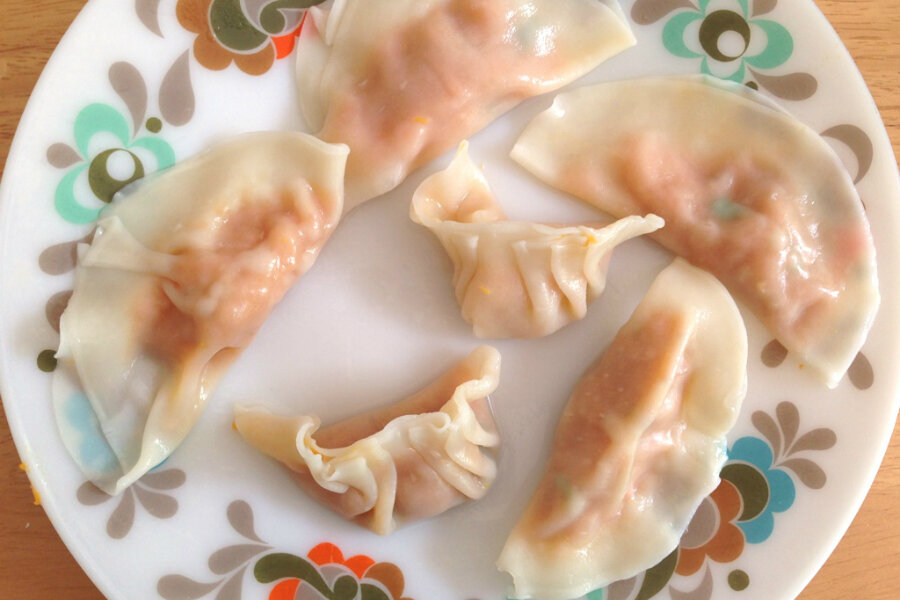Chinese sweet potato dumplings for Chinese New Year
Loading...
On Feb. 19, 2015, we will welcome the Year of the Goat/Sheep. And so begins another round of eating because a new year celebration isn’t a celebration without lots of food!
I’ve written many posts on Lunar New Year foods: from a Singapore favorite, raw fish salad (yusheng), to Indonesian-style pineapple tarts and Chinese New Year cake. I even have a round-up of new year foods from different cultures.
But I have to say that one of my favorite new year foods is a Chinese peasant dish – dumplings called jiaozi. Traditionally, jiaozi dumplings are made with meat (usually pork) and vegetables (often Chinese/napa cabbage), two ingredients that were/are easily available and affordable (click here for a recipe).
These dumplings can be cooked in myriad ways. When they are pan-fried, they’re called guotie or in English, potstickers. Steamed, they are zhengjiao. When boiled, they’re called yet something else – shuijiao.
Jiaozi are eaten year round but they are popular during the New Year because of their resemblance to the golden ingots used during the Ming Dynasty as currency. Thus, they are believed to bring prosperity to those who eat them.
After the reunion dinner on New Year’s Eve, many families will eat jiaozi at midnight to kick off an all-night mahjong session, or the more sedate will have them for breakfast the next morning.
Since jiaozi is a home-cooked dish, every family will have their list of preferred ingredients (shrimp, beef, spinach, etc. are just a few), folding techniques (see photo), and cooking methods (see above).
The same goes for me. I wanted to come up with an easy filling that my son could help me prepare. Plus, I wanted something meatless as too many meat dumplings tend to sink to the bottom of my belly. I found plenty of recipes online, mostly using glass noodles and vegetables.
Then I recalled a lamb and pumpkin dumpling recipe in Jen Lin-Liu’s book, "Serve the People: A Stir-Fried Journey Through China." Flipping through the book, I found it quickly. After reading through it, I thought, why not leave out the lamb? And why not sweet potatoes instead of pumpkin?
I hit gold. My final recipe turned out simple, tasty and very kid-friendly.
Sweet potato Chinese dumplings (Jiaozi)
Makes 35 dumplings
Instead of sweet potatoes, a sweet winter squash that isn’t too watery such as a Japanese squash (kabocha or kuri are perfect), or hubbard would make a fine substitute. For even more convenience, you might want to try canned pumpkin puree (although I must warn you I haven’t tried it)!
1 pound sweet potatoes (about 2 medium), scrubbed
1 large stalk green onion, finely chopped (about 3 tablespoons)
2 teaspoons soy sauce
1 teaspoon sesame oil
1/8 teaspoon ground black pepper
35 round dumpling wrappers
Dipping sauce (see recipe below)
1. Bring a large pot of salted water to boil. Boil the sweet potatoes for 25 to 30 minutes, until tender. Drain in a colander.
2. When cool enough to handle, peel the sweet potatoes and cut into chunks.
3. Mash sweet potato chunks in a large bowl with a fork or potato masher. Add the soy sauce, sesame oil, black pepper, and 2 tablespoons green onions and mix well with a wooden spoon.
4. Set up your prep area. Place the stack of dumpling wrappers under a damp towel to prevent them from drying out. Prepare a small bowl of water. Dust a tray with flour to prevent sticking.
5. Peel wrappers one at a time and hold in your non-dominant hand. Scoop 1 teaspoon of filling into the middle of the wrapper. Dip your finger into the water bowl and moisten the top edge of the wrapper. Pleat the edge or fold over into a half moon. Pinch to seal the edge and lay it standing on the tray. Repeat until all the filling is used up.
6. Bring a large pot of water to boil. Prepare a lightly oiled plate. Gently drop 8 to 10 dumplings into the water, making sure the dumplings can float freely. When the dumplings float to the surface, about 3 minutes, cook for 1 more minute. The dumplings are ready when their wrappers are translucent.
7. Scoop up the dumplings with a slotted spoon and place on the oiled plate. Repeat until all the dumplings are cooked. Serve immediately with dipping sauce.
Dipping sauce
Makes 3/4 cup
1/4 cup soy sauce
1/4 cup rice vinegar
1 teaspoon honey
1/2 teaspoon sesame oil
Hot sauce (such as Sriracha or sambal oelek) to taste
1 tablespoon chopped green onions
Shredded fresh ginger (optional)
Combine all the ingredients in a small bowl and whisk together with a fork.
Related post on Pickles and Tea: Indonesian Pineapple Cookies








